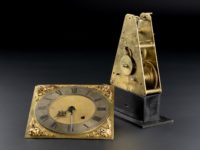 The Bruce-Oosterwijck longitude pendulum sea clock, one of only two examples in the world, has been acquired by National Museums Scotland. The clock is the first mechanical attempt to crack the case of how to calculate longitude during long transatlantic voyages. It didn’t work. Scientists, naval experts and clockmakers would spend another hundred years trying to solve the problem of longitude, but this first failure marks a pivotal moment in maritime history.
The Bruce-Oosterwijck longitude pendulum sea clock, one of only two examples in the world, has been acquired by National Museums Scotland. The clock is the first mechanical attempt to crack the case of how to calculate longitude during long transatlantic voyages. It didn’t work. Scientists, naval experts and clockmakers would spend another hundred years trying to solve the problem of longitude, but this first failure marks a pivotal moment in maritime history.
Latitude (the north-south position) can be calculated by the height of the sun and stars in the sky; navigators had that one figured out thousands of years ago. Longitude (the east-west position) was a much harder nut to crack because it required a timepiece that could keep accurate time during a voyage that would allow sailors to calculate how far east or west they’d traveled from their point of origin.
 Alexander Bruce, 2nd Earl of Kincardine, commissioned the clock in 1662 from The Hague clockmaker Severyn Oosterwijck. The pendulum clock had only been invented a few years earlier and was by far the most accurate timepiece ever created up until that point. (It would remain the most accurate timekeeper until the 1930s.) Oosterwijck had played an important role in its development by horologist Christiaan Huygens. Since the pendulum kept such precise time for so long, perhaps it could solve the longitude problem.
Alexander Bruce, 2nd Earl of Kincardine, commissioned the clock in 1662 from The Hague clockmaker Severyn Oosterwijck. The pendulum clock had only been invented a few years earlier and was by far the most accurate timepiece ever created up until that point. (It would remain the most accurate timekeeper until the 1930s.) Oosterwijck had played an important role in its development by horologist Christiaan Huygens. Since the pendulum kept such precise time for so long, perhaps it could solve the longitude problem.
The first practical pendulum clock was invented in 1656 by the Dutch mathematician and astronomer Christiaan Huygens (1629–95). He then turned his attention to the creation of an accurate sea clock for the determination of longitude.
Huygens collaborated with Bruce on the project, with the Scot introducing a number of new features to the Dutchman’s designs before having four sea clocks made, two of them by Severyn Oosterwijck.
By the end of 1662, Bruce’s initial sea-trials were proving promising. More formal sea-trials were carried out, with reports suggesting that the clocks had performed exceptionally well.
However, these reports eventually proved to be inaccurate. Captain Robert Holmes, who had been entrusted with the trials of the clocks (though his attention was clearly more devoted to plundering Dutch merchant shipping), had reported implausible success beyond even the best hopes for the clocks. Samuel Pepys was asked to investigate, and it transpired that the glowing reports were entirely fictitious. Despite the optimism of the 1660s and extensive discussions over patents and profits, the new marine timekeepers turned out not to be the solution that had been hoped for.
Its mission failed, the Bruce-Oosterwijck clock fell into obscurity. It was probably used as a normal household clock from around 1670 through 1972 when it appears again on the record. It was valued as a late 17th century pendulum clock, but its true significance wasn’t discovered until recently.
Thanks to sizeable grants from the National Heritage Memorial Fund and the Art Fund, National Museums Scotland was able to acquire the Bruce-Oosterwijck sea clock. It will go on permanent display in the Earth in Space gallery at the National Museum of Scotland in Edinburgh.